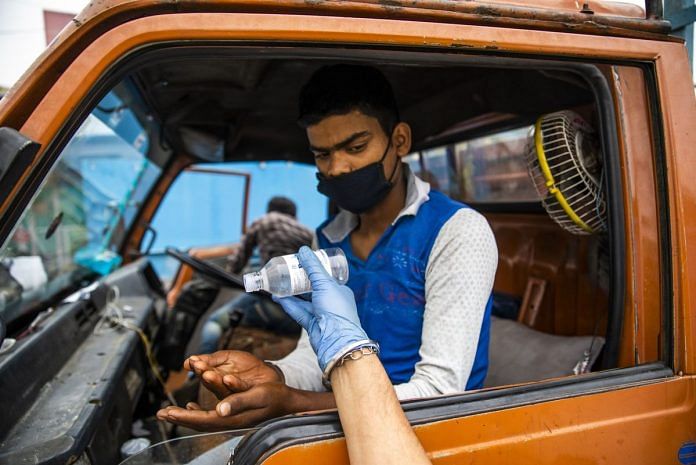New Delhi: When Bharat Gite reopened his aluminum parts factories in India’s western city of Pune, he spent days servicing idle machines, sanitizing his premises and putting in place social distancing norms for staff.
His bigger problem now is convincing workers to return to their jobs after millions of Indians fled cities for their rural homes when Prime Minister Narendra Modi imposed a nationwide lockdown at the end of March. Gite supplies companies like General Electric Co., ABB Ltd. and Siemens AG, and he says sales orders have dried up. The two factories run by his Parc Robotic Systems Pvt. Ltd. are operating at just a tenth of their capacity and with 30% of labor, he says.
“We haven’t heard from customers in the last two months,” Gite said by phone from Pune. “It’s totally a havoc situation. We don’t know what is going to happen.” The biggest uncertainty is “how to bring the workforce back,” he said. “It will take at least a year for the business to come back on track.”
As India begins gradually easing stay-at-home restrictions across the country, Gite’s experience shows how reopening the economy isn’t going to be a straightforward exercise. On top of the labor shortages and slack demand, businesses are living with the threat they’ll be shut down for several weeks if a single infection is detected, forcing them to proceed with caution. That dispels any notion of a quick recovery in an economy facing its first contraction in more than four decades and hundreds of millions of job losses.
“If one person is infected, the whole factory will be closed for 28 days. That is a fear among entrepreneurs,” said Chandrakant Salunkhe, president of the SME Chamber of India, which represents small- and mid-sized businesses in the country. “Even if I start my factory now, I’ll not get raw material. If I have raw material, I don’t have labor, and if I have labor I don’t have orders. Supply chain has totally broken down.”
Restrictions Eased
Small and mid-sized businesses in India account for about a third of gross domestic product and employ more than 110 million people. It’s this sector of the economy that’s experiencing the brunt of the jobs and financial pain from the pandemic and subsequent lockdown.
India went into a lockdown on March 25, with Modi extending the stringent stay-at-home restrictions twice — first until May 3 and then again until May 17. He began easing curbs last week on the production, sale and transport of goods in areas where virus cases are less severe.
Despite the lockdown, infections have continued to spread. Confirmed cases stand at more than 56,000, with almost 1,900 deaths. The country’s top 10 Covid-19 affected states contribute 66% to the nation’s gross domestic product, according to Deutsche Bank AG.
Districts are now split into red, orange and green zones, depending on the intensity of the outbreak, and are adjusted on a weekly basis. Most of the major cities in the country, which drive the economy and jobs, are in red zones.
But even in areas where businesses are resuming, workers who left their jobs to return to their villages when the lockdown was put into place aren’t making the return journey. The construction industry, the country’s biggest job creator, is facing severe shortages. Property developers like Runwal Group and Goodwill Developers said they aren’t expecting workers to return to their jobs anytime soon.
“Combined with the challenges posed by raw material supply being disrupted as lockdown lifts in a disjointed way across the country, labor shortages will further delay the economic recovery with resulting implications for social stability,” said Akhil Bery, a Washington-based analyst with Eurasia Group.
There have also been tragic consequences as some factories began reopening. A gas leak occurred at an LG Chem Ltd. polymer plant in southern India last week after it was restarted, killing at least 11 people and forcing thousands more to evacuate. Officials said the plant was old and the government will issue new safety guidelines for factories restarting after the lockdown.
Also read: Mukesh Ambani now courts Saudis and investors who backed Uber, Airbnb for Jio
GDP Contraction
The devastating economic effects of the pandemic are starting to become clear. Purchasing managers surveys in the manufacturing and services sectors suggest a 15% contraction in GDP in April, while separate research by a private sector think tank estimates 122 million people lost their jobs. Bloomberg Economics’ Abhishek Gupta is forecasting GDP will shrink 4.5% in the fiscal year through March 2021, while Nomura Holdings Inc.’s Sonal Varma sees a decline of 5.2%.
While the government sees a contraction in the current quarter, it’s still predicting growth for the full financial year, of 2%. Finance Minister Nirmala Sitharaman said last week the economy was “poised to recover” as state-run banks approve more loans to small- and mid-sized businesses.
During March-April 2020, PSBs sanctioned loans worth Rs 5.66 lakh cr for more than 41.81 lakh accounts. These borrowers are from MSME, Retail, Agriculture & Corporate sectors, waiting for disbursal soon after #lockdown lifts. Economy poised to recover! @FinMinIndia @DFS_India
— NSitharamanOffice (@nsitharamanoffc) May 7, 2020
Officials are also working on a fiscal package to support businesses, including possibly guaranteeing as much as $39 billion of loans to small businesses, according to people familiar with the matter.
Priyanka Kishore, an economist with Oxford Economics Ltd. in Singapore, said industries like transport, hotels and restaurants, trade and construction will take a big hit due to the lockdown. But even in sectors where restrictions have been lifted, it will be a slow road to recovery.
“We don’t look for normal resumption of activity even in sectors that are now exempted, such as agriculture, certain manufacturing industries and financial services,” she said.-Bloomberg
Also read: India to grow between 0 to -2%: Economists lower forecast as 3rd lockdown delays revival






